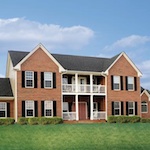Studio Fusion at a Glance
Location
Charlotte, NC
Founded
2008
Employees
11
Specialties
Architecture, interior design, graphic design, branding
How did your firm come together despite the economic crunch surrounding its founding?
Carrie Frye: Studio Fusion was actually formed from two different companies that came together. The studio I was with, Lava Studio, reached out to our friends at another studio, Via II, for a joint venture. In forming this, we found that what we were missing, this other firm had—and what the other firm was missing, we had. When we got together, we had good synergy and thought that this is something we should do more permanently. From when we started in 2008 to now, we stayed busy. Restaurant and office work continued through the whole downturn.
When did you start working with Firebirds?
CF: My relationship with Firebirds goes back to 2005. Firebirds was a developed brand that had 10 stores at that point and was just getting into a rhythm. They’re constantly looking at how they can update their brand, so they went out to people they knew in the Charlotte community, and luckily for me, they kept hearing my name, so I started working with them. Then, when we started at Studio Fusion, Firebirds wanted to continue our relationship. We’re on our 13th store with them, and we are constantly looking at creative new ways to mold and update their look.

What all does Studio Fusion do for Firebirds?
CF: The restaurant [chain] has a Rocky Mountain grill concept with wooden trusses, stacked stone, clean lines, and a large fireplace. It’s very comfortable, and we do everything from soup to nuts for Firebirds. We literally start working with them when they’re negotiating the lease, and then we do space planning, concepting, exterior concepts, all of the construction drawings, and all of the finishes, including the furniture.
What advantages does a soup-to-nuts approach give you?
CF: There are so many factors that tie into every project. If you leave one thing out, there could be a problem. We have had situations in the past with our retail projects where we’ve done the design but their logo, which we didn’t design, ended up contradicting everything we had done in the interiors. The logo, branding, and everything happening on the outside of the building has to make sense with what’s happening on the inside in order for it to be a really strong brand and for it to be a well-known brand that people recognize.
So you must be involved in Firebirds’ general development, too.
CF: Some of what we do is standard, though for the furniture, for example, we’ve recently been looking at some new fabrics and upholstery. Every time we build a restaurant, we come up with something a little bit easier to manage. We work with several general contractors who know what they’re doing and tweak as we go. We want the restaurant to look good and be successful. We want it to be easy for [the owner] to operationally maintain and keep clean. We’re constantly looking at the lighting as well. We actually simplified [Firebirds’] lighting situation, which originally had 20 different types of fixtures, and slimmed it down to three. Now we’re moving toward doing all LED lighting.
Is it tough working with a client so comprehensively?
CF: It puts the onus on us, but we prefer that because we have much more control over how the whole project comes together. This translates into our projects having stronger design elements. We pitch this to every restaurant project that we start. Owners who have seen examples of our work approach us and say, “This is what we want.” We then tell them about our design process and client experience with our other projects, like Firebirds. We let them know what they can do in order to get their own projects to look similar while still adding a personalized flair at the same time. ABQ



